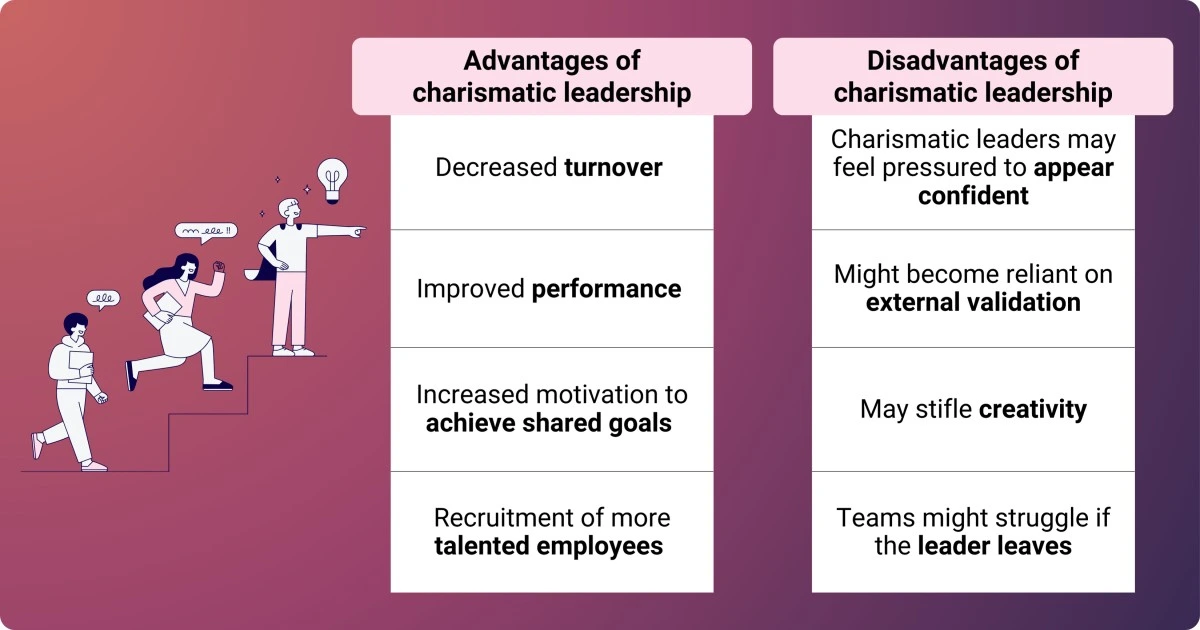What Is Charismatic Leadership? Exploring the Theories, Impact, and Examples

Some leaders seem to exude confidence and charm effortlessly. Maybe they’re always ready to give an impromptu speech to rally the team, or they have the uncanny ability to win over anyone. And every time you chat with them, their enthusiasm and passion rub off on you.
It’s easy to assume these traits are innate – either you’re a natural charmer or not. But no one is born knowing how to work a room or woo clients. Instead, these leaders have mastered the art of charismatic leadership, a style that uses personal charm and interpersonal communication to influence others.
Like any skill, you can learn how to become a charismatic leader with effort and time. Keep reading to discover this style’s traits, benefits, and impact in the workplace.
Understanding charismatic leadership theory
In the business world, charisma goes beyond a friendly personality. It’s an influential leadership style that inspires others to excel. So what is charismatic leadership, and what are its defining traits?
Definition and origins
Charismatic leadership is defined as “inspirational leadership governed by self-confidence, authoritativeness, and the ability to put people in touch with their feelings,” as noted by group psychotherapist Harold Behr in his research, "Charismatic leadership: a group-analytic perspective." According to Behr, these leaders are typically driven “by a strong sense of purpose.”
An article in Evolution and Human Behavior on Charismatic leadership and the evolution of cooperationOpens in a new tab notes that charismatic leadership has a long history that predates the modern workplace. Over 2,000 years ago, St. Paul coined “charisma” to describe “an inexplicable gift from the divine.” In his view, this quality was an inborn characteristic possessed by only a few individuals.
In the mid-20th century, the German sociologist Max Weber redefined charismatic leadership, describing it as a style of rule rather than a personal trait. This type of authority, he wrote, occurs when someone “is set apart from ordinary men and treated as endowed with supernatural, superhuman, or at least specifically exceptional powers or qualities.”
Of course, charismatic leaders aren’t actually superhuman or supernatural. Instead, they’ve developed leadership core competencies that inspire others to follow them.
Key characteristics of the charismatic leadership style and how to develop them

Charismatic leaders can come from any background but share a few defining traits. Here are the essential qualities you need to develop leadership skills in yourself and your team.
1. Visionary thinking
Many employees focus on immediate tasks, often looking only as far as the next project or meeting. Charismatic leaders, on the other hand, are future-oriented. They have a knack for seeing beyond the present and creating a clear vision for the future. This ability shapes their actions and inspires others to work toward achieving their goal.
Focusing on long-term objectives is key to becoming a visionary thinker. Consider what you want to accomplish in the next 5 to 10 years, and don’t be afraid to dream big. For example, you might aim to transform your organization’s culture or invent a revolutionary product. By developing a bold and clear vision, you can motivate others to work together and drive meaningful change.
Visionary thinking also requires a healthy appetite for risk. Learn how to weigh the pros and cons of each opportunity so you can make bold – but not reckless – decisions. This might involve using predictive analytics software to explore potential outcomes or seeking guidance from an experienced mentor.
2. Emotional connection
Charismatic leaders often have strong emotional intelligence, allowing them to manage their feelings while connecting with their followers on a deeper level. They frequently express empathy and try to understand where their team members are coming from. These seemingly small gestures go a long way toward building trust and rapport in an organization.

Developing emotional intelligence begins with improving self-awareness. Take a few minutes to journal about your feelings daily, or track them using an app like MoodfitOpens in a new tab. This practice helps you get in touch with your emotions and learn how to regulate them.
Practicing active listening is one of the most effective emotional intelligence activities in the workplace. Give team members your full attention, and observe their nonverbal and verbal cues to better understand how they’re feeling. Over time, you’ll become more adept at recognizing and responding to the emotions of others.
3. Strong communication skills
Excellent communication skills are a hallmark of charismatic leaders. These individuals are often powerful storytellers who captivate audiences with their inspiring language and vivid imagery. They use these abilities to engage listeners and effectively convey their ideas.
To sharpen your communication skills, study great storytellers. Watch famous speeches and TED Talks, analyzing how the speakers communicate their ideas. Pay attention to their body language and the strategies they use to shape their narratives.
Next, look for opportunities to apply your knowledge and receive constructive feedback. For example, you could join a local Toastmasters club to practice public speaking or volunteer to write a report for your team. These low-stakes activities enable you to become a stronger and more persuasive communicator.
4. Confidence and enthusiasm
A charismatic leader oozes confidence without coming across as arrogant or brash. They face challenges with poise, staying cool and collected during crises. They’re also deeply passionate about their work and mission, inspiring their team to follow suit.
To build self-confidence, set ambitious but feasible goals for yourself, and celebrate your achievements. Maintain a positive mindset, even when you're stressed, and focus on empowering others instead of tearing them down. And don’t underestimate the importance of dressing well and standing up straight. These strategies will help you develop a commanding presence and trust yourself more.
5. Personal magnetism
People often feel irresistibly drawn to charismatic leaders. Many factors come together to create a magnetic personality, such as body language, demeanor, and interpersonal interactions. For instance, a magnetic person may use humor to set others at ease or be a charming conversationalist.
There’s no one-size-fits-all approach to gaining personal magnetism, but you can start by improving how you engage others. Show genuine interest in people by asking thoughtful questions and looking for common ground. Open body language, such as nodding and keeping your arms uncrossed, also helps you build meaningful connections.
6. Ability to inspire loyalty
Charismatic leaders stand out for their ability to gain their followers’ loyalty. These leaders excel at building personal connections with their teams, motivating them to go above and beyond.
Inspire loyalty by building strong relationships with your team and recognizing their contributions. You should also practice transparency and integrity at all times to gain their respect.
Charismatic leadership advantages and disadvantages

While charismatic leadership can energize and inspire teams, it also comes with a few potential drawbacks. Here are a few factors to weigh as you analyze how this leadership style may affect your career trajectory and organization.
Advantages
Charismatic leadership is all about empowering individuals and transforming organizations. A study titled 'The Impact of Charismatic Leadership on Recruitment, Development and Firm PerformanceOpens in a new tab,' published in the Journal of Managerial Issues, revealed many benefits to this approach, including:
- Decreased turnover
- Improved performance
- Increased motivation to achieve shared goals
- Recruitment of more talented employees
Additionally, research from the Journal of Organizational Effectiveness on the role of transformational leadership and mission valence on burnout among hospital staffOpens in a new tab found that charismatic leadership can help reduce burnout and job-related stress, improving employees’ well-being.
Disadvantages
Many teams thrive under charismatic leadership, but it’s not the right fit for every organization. Here are a few potential disadvantages of charismatic leadership:
- Charismatic leaders may feel intense pressure to appear confident and charming, leading to psychological distress.
- These leaders might become overly dependent on external validation.
- This style may stifle creativity and innovation, especially if dissenting ideas and voices are discouraged.
- Some teams may struggle to perform or fall apart if their charismatic leaders leave.
Charismatic leaders can reduce these risks by encouraging followers to challenge them and share bold ideas. Organizations should also hold all members to high ethical standards and promote personal accountability.
Charismatic leadership theories and models
Charismatic leadership may seem straightforward, but researchers continue to investigate its effects on followers and organizations. Familiarizing yourself with theories and models will help you understand how to apply this leadership style effectively.
Weber’s theory of charisma
In the 1940s, Weber developed the concept of charismatic authority to describe the relationship between an exceptional leader and their followers. This authority challenges traditional rules and structures, often leading to revolutionary change.
Weber’s theory expanded our understanding of how a leader’s personal traits can attract and motivate followers. He also suggested strategies for “charismatic succession” to help organizations with leadership succession planning when leaders leave or lose their power.
House’s path-goal theory
In 1971, leadership expert Robert House built on Weber’s ideas with the path-goal theory. It states that a leader’s behavior directly affects employee motivation and performance.
According to House, leaders can support their teams by clearly communicating goals and removing obstacles from their path. He also believed leaders should continually adapt their style to fit their staff’s needs.

Conger and Kanungo’s model
In 1987, Jay A. Conger and Rabindra N. Kanungo developed a model to explain how charismatic leaders use their behavior to influence others. According to this model, these leaders:
- Engage in novel or unconventional behaviors
- Take personal risks to accomplish a shared vision
- Critique the status quo and present a more attractive vision of the future
These behaviors help charismatic leaders build devoted followings and practice purpose-based leadership.
Impact of charisma in leadership
Effective leadership doesn’t exist in a vacuum. Charismatic individuals can powerfully impact their followers and the broader organization.
Influence on followers
Charismatic leadership can be highly contagious, in the best sense of the word. According to "Contagious charisma: the flow of charisma from leader to followers and the role of followers’ self-monitoring," a 2023 Sec Organizational Psychology study, "charisma can cascade downward from the leader to followers.”
In other words, followers often mimic charismatic leaders’ attitudes, behaviors, and traits. This influence can create a sense of shared purpose, inspiring followers to work toward the leader’s goals. It may also improve performance and productivity by boosting motivation.
Organizational outcomes
Research indicates that charismatic leadership can positively influence organizational culture and success. For example, one study published in The Leadership Quarterly onthe effects of charismatic leadership and organizational culture on objective and perceived corporate performanceOpens in a new tab found that this style of leadership improved a Dutch bank’s financial performance.
Another study, "The Impact of Charismatic Leadership on Organizational Culture," published in the Qalaai Zanist Journal, demonstrated how charismatic leadership contributed to more adaptable and innovative organizational cultures in Iraq.
However, a study on unethical pro-organizational behaviorOpens in a new tab published in the International Journal of Environmental Research and Public Health found that the charismatic leadership style also presents several risks to organizational health. Followers may feel intense performance pressure to appease their leaders.
As a result, they may engage in unethical pro-organizational behavior – actions that benefit leaders but violate social values.
Examples of charismatic leaders
Analyzing the actions and messages of real charismatic leaders can provide useful insights to help you become a how to be a good manager and leader. Here are a few case studies for inspiration.
Historical figures
Martin Luther King Jr. is widely regarded as one of the most charismatic figures of the 20th century. His speeches – most notably his famous “I Have a Dream Speech” – are a masterclass in persuasive rhetoric and visionary thinking. In advocating for civil rights, he exemplified perseverance and bravery in the face of serious challenges.
Similarly, Eva “Evita” Perón used her charisma to benefit society. As the wife of the Argentine president Juan Perón, she wielded her influence to create thousands of hospitals, schools, and other nonprofit organizations. Her actions helped her gain the ardent support of Argentina’s working-class citizens.
Modern leaders
Many contemporary leaders also display charismatic leadership traits. For example, former president Barack Obama is often lauded for clearly conveying his vision about healthcare reform and other political policies.
In the business world, Indra Nooyi, the former CEO of PepsiCo, demonstrated charismatic leadership through her ability to connect with others and gain trust. In a CNBC interviewOpens in a new tab, she explained, “I realized that I could have all the anxieties inside, but to the company, I had to project confidence, optimism, a can-do spirit, and a must-do resolve.”
These personal traits helped her win over her new team and accomplish her bold visions, such as replacing the company’s information technology systems.
Transform your organization as a charismatic leader
With their magnetic personalities, charismatic leaders can wield immense power over their followers and organizations. For these visionaries, rallying teams around a shared cause and driving innovation is all in a day’s work.
While anyone can develop charismatic leadership traits, it probably won’t happen overnight. Focus on developing essential skills, such as nonverbal communication and emotional intelligence. Workhuman’s AI Assistant can help you identify skill gaps and create a plan to address them. With patience and persistence, your leadership abilities – and influence – will grow.